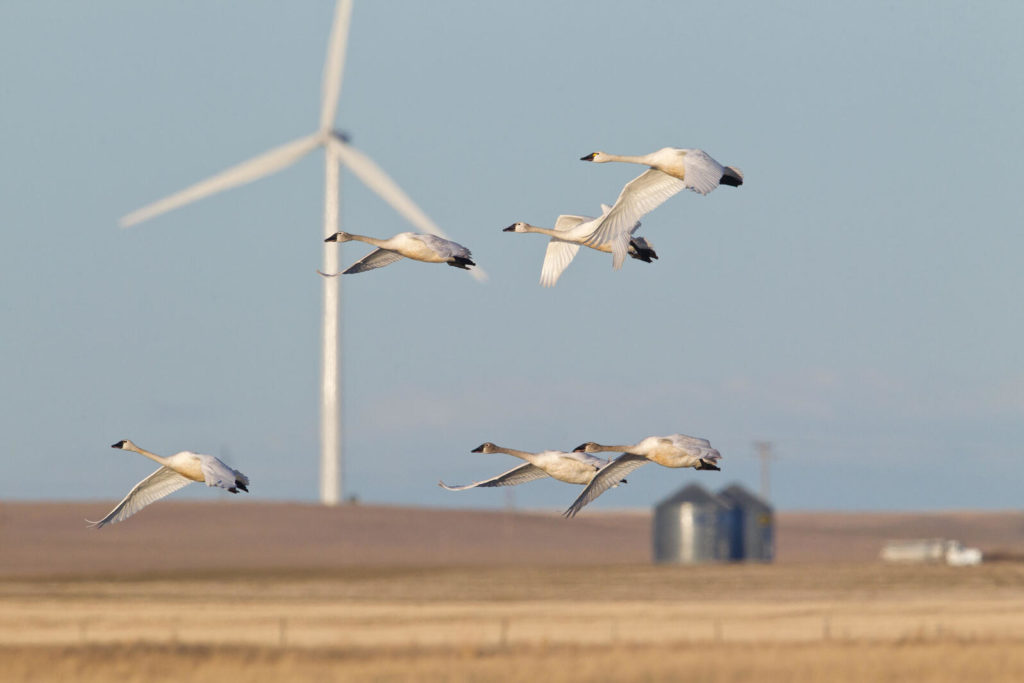Throughout a grueling eight-year legal battle between Osage Nation, Enel Green Power, and the National Audubon Society, coexistence of all parties has been difficult at best. While clean energy is scientifically sound as a climate change solution, navigating the complexities between the environment and American Indian tribal sovereignty has posed many challenges since 2013.
“At the time, we objected to a broad rule adopted by the Department of Interior that would give wind farms more leeway to kill eagles,” Robyn Shepard, the communications director for advocacy at Audubon, explained via email about a 2013 ruling allowing 30-year permits for wind farms. Audubon strongly opposed the ruling that allowed for unmitigated construction of wind farms to be built in the migratory paths of birds, including bald and golden eagles. A federal judge later overturned this rule in 2016.
Wind power facilities can also degrade or destroy habitats, cause disturbance and displacement, and disrupt important ecological links. Placing wind projects in the path of migratory routes makes this problem worse, especially for larger turbine blades that may reach up into the average flight zone of birds that migrate at night. According to Audubon, an estimated 140,000 to 500,000 bird deaths occur per year due to turbine collisions, which is substantial, but significantly less than the deaths that would be caused by the impacts of the climate crisis. Audubon believes that wind energy’s benefit to birds by curbing climate change outweighs the harm, through direct collisions with turbines and other structures such as power lines. Shepard explained that Audubon supports wind and other renewable energy resources and recognizes that there will be some impact to birds in particular, but with the insight of environmental groups like Audubon, construction can be completed responsibly. Because of regulations such as The Migratory Bird Treaty Act, The Endangered Species Act, and The Bald and Golden Eagle Protection Act, companies are held responsible for their impacts. The penalties under the bird-protection law are critical incentives for companies to take common-sense precautions to help reduce bird kills, such as covering oil pits with nets and marking transmission lines so they are more visible to migrating birds. The penalties create a helpful incentive to remind companies to do the right thing for wildlife.
Shepherd stated that Audubon no longer has a stake in the United States vs Osage Wind case since 2016, when they received further legal protection with The Migratory Bird Treaty Act. Information from Osage Mineral Council Attorney Wilson Pipestem, public records, and the Oklahoma Bar Association revealed just how messy this case truly is despite the parent company of Osage Wind, Enel, declining to comment on the ongoing case.
According to the Oklahoma Bar Association, in 2011 Osage Wind—a name unassociated with and appropriated from Osage Nation—leased over 8,000 acres in Osage County to construct a wind farm. Between 80 and 100 turbines were planned for the wind farm, as well as a substation, an overhead transmission line, two meteorological towers, and access roads—an estimated footprint of between 100 and 200 acres within the leased acreage. The mineral council of Osage Nation then sought to prevent the construction under both federal and state laws on the basis that the proposed wind farm would interfere with The Mineral Council’s use of the surface estate for oil and gas development. As part of its effort though, the tribe presented insufficient evidence relating to the conflict. After pointing out that structures would take up less than 1.5% of the leased acreage, the court found the claim could not be supported. Accordingly, the district court denied the Osage Nation’s requests and Osage Wind began site preparation and excavation for the windmill foundations.
Pipestem explained the complexities of the situation stating that wind energy is not bad, but the land chosen is on top of oil fields—a large source of income for the tribe. The income that would be generated is money the tribe would not see and on top of that, Osage Wind overstepped their boundaries even further.
“The nation realized Enel was going into the land taking limestone and other rock using it to build the foundation,” Pipestem said. “The Bureau of Indian Affairs sent them a cease and desist because those are Osage-owned minerals and you cannot mine without permission of the Osage Mineral Council,” he said.
Shortly after, the United States stepped in on behalf of Osage Nation with a lawsuit in response to the mining.
“Not only did they violate federal law but they violated our sovereignty,” Pipestem said. A trial date is yet to be decided and Pipestem expects a trial in court unless there can be a settlement before then.
Without a response from Enel to elaborate on their intentions, it further raises the question: would the wind farm primarily benefit Enel and its customer base outside of the reservation? Is this another scenario where green energy will benefit those who are privileged instead of the reservation? According to a study by UCLA, wealth is a prominent driver of demand for energy consumption. Worldwide, wealthier groups lead more materially and energetically intensive lives than the less affluent, consuming in excess of what they require to meet their essential needs.
Tribes like Osage need a means for income and the world needs a future away from fossil fuels. It is hopeful that green energy companies and tribes can work together to make sure that the tribes can financially benefit as an incentive to inspire green actions by all parties. If anything can be gained from this situation, it is the need for a world where tribal land isn’t exploited for financial gain and a world where green energy can coexist with tribal sovereignty so that there can be an environmental and ethical solution.
Also by Natasha: A Brief History Of Greenwashing—And What To Watch Out For
Get more like this—Sign up for our daily inspirational newsletter for exclusive content!
___
Photo: Donald Jones via Audubon Society





